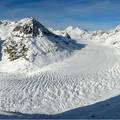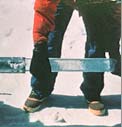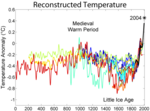 |
|
|
When snow falls to the ground it traps tiny amounts of air between the snow flakes. As more snow falls, the weight above compresses the snow below into ice, trapping these tiny pockets of air. These form a record of the air composition at the time the snow fell. The deeper down the air pocket, the older the air. Scientists have drilled into the arctic snow, down through hundreds of metres of ice, extracting ice cores and thus air pockets from thousands of years ago. By analysing the gases in these and how far down they are in the ice core, they can work out how much carbon dioxide and other gases were present in the air when the snow fell and how old it is. Mud cores
|
 |
Many glaciers around the world are melting at an alarming rate. ![]() Look at this website documenting recent and old photos of the same glaciers.
Look at this website documenting recent and old photos of the same glaciers.
Follow the story
This video shows how evidence for climate change has gradually grown since the 1950's. Notice how much science is a process of experts regularly disagreeing. Debate and managing disagreement in order to come up with better explanations is an essential part of how science eventually arrives at the best evidence.
This is a YouTube video. If you can't see it in your school, ask your teacher to show it to you.
A summary of climate change evidence by Peter Hadfield, New Scientist correspondent for 14 years, and regular contributor to science programmes for the BBC and ABC (Australia).
![]() More about the author of this video
More about the author of this video ![]() More videos about the science of climate change from this author
More videos about the science of climate change from this author
![]()
Modelling climate change
or
Climategate: Ethics in sharing data





What's your opinion?
Average rating




Not yet rated